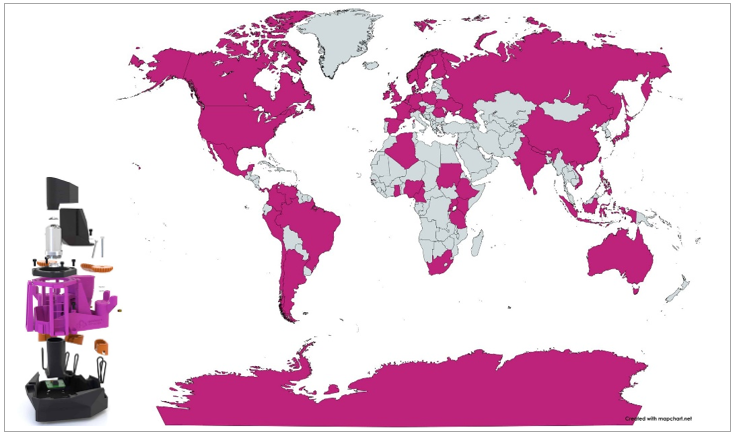
BREAKTHROUGH: New affordable microscope to improve diagnosis

A new and affordable microscopy solution, the OpenFlexure Microscope, once just an academic project, is now set to change medical diagnostics, especially in remote and low-resource settings.
Introduced in 2016, the tool provides sufficient image quality to detect diagnostic features such as parasites and cancerous cells, addressing the problem of insufficient high-quality lab microscopes in many regions.
In an article on the Philosophical Transactions of the Royal Society journal, a team of scientists from multiple institutions, including the University of Glasgow (UK), Baylor College of Medicine (USA), University of Bath (UK), Foxhill Engineering (UK), Ifakara Health Institute (Tanzania), Bongo Tech and Research Labs (Tanzania), Mboalab and African Higher Institute of Open Science and Hardware (Cameroon), and MD Anderson Cancer Centre (USA), underscored the potential impact of the microscope.
They detail its journey from an academic prototype to a potential medical device, highlighting the essential steps required to ensure it meets the standards for medical devices, including overcoming potential challenges.
The role of optical microscopes
Optical microscopes play a vital role in medical diagnostics, enabling the identification and characterization of several conditions such as cancer, sexually transmitted infections, and parasitic infections. However, the limited access to high-quality, well-maintained microscopes and trained personnel often hinders reliable diagnosis, forcing patients to undertake long journeys to health centers for testing and treatment.
Tackling this challenge requires enhancing local diagnostic capabilities by providing access to high-quality, reliable microscopes. This need has driven the development of the OpenFlexure Microscope to support healthcare in low-resource settings such as in Tanzania for diagnosing malaria and oesophageal cancer in Brazil.
Features and functionality of the microscope
The OpenFlexure Microscope, first announced in 2016, is a three-dimensional-printed device capable of automatically moving, focusing and capturing digital images of samples. Both its hardware and controlling software are open source, enabling users to manufacture, use, modify and sell the designs without restriction from patents or copyright.
Notable for its accessibility and affordability, the microscope can be used in diagnosing health issues right where patients are, without the need to send samples to distant labs.
“As access to lab-grade microscopes is a major challenge in global healthcare, the OpenFlexure Microscope has been developed to be manufactured, maintained and used in remote environments, supporting point-of-care diagnosis,” noted the scientists.
They further explained, “The steps taken in transforming the hardware and software from an academic prototype towards an accepted medical device include addressing technical and social challenges and are key for any innovation targeting improved effectiveness in low-resource healthcare.”
Why clinician validation is vital
The scientists also discuss the considerations and challenges in turning an academic prototype into a medical device for global health, noting the importance of clinician’s approval and feedback which is key to the device’s success.
“Ensuring the trust of clinicians is key to all future goals for microscope deployment in healthcare,” they noted adding, “This development extends beyond purely technical challenges; the project requires acceptance from clinicians to test, feedback on and use the device.”
Furthermore, the scientists noted that while medical certification would give credibility to the OpenFlexure Microscope, feedback from target end users, the clinicians, in this case, would indicate its acceptance.
Adoption of the microscope
Currently, the OpenFlexure Microscope is at Technology Readiness Level 7 and has been tested in real-world settings, scanning patient blood samples in Tanzanian health clinics and biopsies at the Michael E. DeBakey VA Medical Center in Texas. The next step is to meet ISO 13485 standards, which will further prove its reliability and effectiveness.
“This development has surpassed the typical scope of an academic project—the further release of manufacturing-ready designs, technical documentation and support are all required for widespread adoption.”
The scientists credit the success of OpenFlexure Microscope not just to its innovative technology, but also to a spirit of teamwork. Partners including Mboalab, Bongo Tech, and the Baylor College of Medicine, have brought crucial expertise to ensure the final product is both innovative and practical.
Ifakara scientists involved in the study
Catherine Mkindi and Joram Mduda, scientists from Ifakara, were instrumental contributors to the article.
Additional scientists involved include Joe Knapper, Freya Whiteford, and Richard Bowman from the University of Glasgow; Daniel Rosen and Sharmila Anandasabapathy from Baylor College of Medicine; William Wadsworth from the University of Berth; Julian Stirling from Foxhill Engineering; Valerian Sanga and Paul Nyakyi from Bongo Tech and Research Labs; and Thomas Hervé Mboa Nkoudou, Elisée Jafsia, and Stephane Fadanka from Mboalab and the African Higher Institute of Open Science and Hardware. Kelsey Hummel from MD Anderson Cancer Centre also contributed.
Read the publication here.
